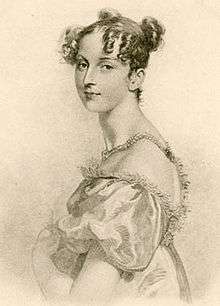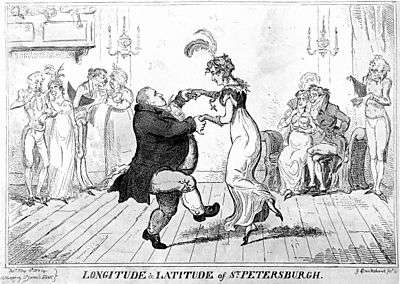Dorothea Lieven
| Dorothea Lieven | |
|---|---|
 Princess von Lieven line engraving by William Bromley, after a drawing by Sir Thomas Lawrence, published 1825; original in the Hermitage Museum | |
| Born |
17 December 1785 Rīga, Livonian Governorate, Russian Empire |
| Died |
27 January 1857 (aged 71) Paris, France |
| Spouse | Christopher Lieven |
| Father | Christopher von Benckendorff |
| Mother | Juilane Schilling von Canstatt |
Princess Dorothea von Lieven (Russian: Дарья Христофоровна Ливен, Daria Khristoforovna Liven), née Benckendorff (17 December 1785 – 27 January 1857) was a Baltic German noblewoman and wife of Prince Khristofor Andreyevich Lieven, Russian ambassador to London, 1812 to 1834. She was also an influential figure among many of the diplomatic, political, and social circles of 19th-century Europe.
Early life
Dorothea von Benckendorff was born into Russia's distinctive Baltic nobility to a Baltic German family in Riga in today's Latvia, daughter of General Baron Christoph von Benckendorff (Friedrichsham, 12 January 1749 - 10 June 1823), who served as the military governor of Livonia, and wife Baroness Anna Juliane Charlotte Schilling von Canstatt (Thalheim, 31 July 1744 - 11 March 1797), who held a high position at the Romanov Court as senior lady-in-waiting and best friend of Empress Maria Fyodorovna, and paternal granddaughter of Johann Michael von Benckendorff and wife Sophie von Löwenstern.
Dorothea was the sister of the Russian generals Alexander and Konstantin von Benckendorff.[1] Her other sister Maria von Benckendorff (Saint Petersburg, 1784 - ?) married Ivan Georgievich Sevitsch.
Educated at St. Petersburg's exclusive Smolny Convent Institute, von Lieven was assigned as a maid of honour to Maria Fyodorovna. In St. Petersburg on 1 February 1800, at age fourteen, some months after finishing her studies, von Lieven married General Count (later Prince) Christopher Lieven. Although the marriage was arranged, the couple managed to live in harmony for many years; only in the last years did serious differences arise between the couple, leading to a total estrangement. They had one daughter and five sons, three of whom predeceased their mother: Magda, Paul (24 February 1805 - 1866), Alexander (9 March 1806 - 5 October 1885), Konstantin (1807 - 1838), Georg and Arthur.
Ambassador's wife
In 1810 her husband was appointed minister to Berlin. When Tsar Alexander I appointed Count Lieven ambassador to Great Britain in 1812, Dorothea von Lieven used her intelligence, charisma, and social skills to make herself a leader of London's politically infused society, thereby contributing materially to the success of her husband's embassy.[2]
In London, Princess Lieven cultivated friendships with the foremost statesmen of her day. As well, she and Austrian Chancellor Prince Klemens Lothar Wenzel von Metternich had a notorious liaison. She was also reputed to have had an affair with Lord Palmerston, although there is no firm proof of this.[3] She was a close friend of Lord Castlereagh, and was one of the first people to voice concerns about his increasingly strange behaviour in the weeks leading up to his suicide.[4] Lord Grey confided in her, even sharing with her his intense grief on the death of his grandson Charles in 1831; on the other hand she admitted that the details of what became the Reform Act 1832 came as a complete surprise to her, which may be a sign that Grey despite their friendship did not entirely trust her.[5]
In England's vibrant political environment, the Princess discovered in herself a flair for politics. She also became a leader of society; invitations to her house were the most sought after and she was the first foreigner to be elected a patroness of Almack's, London's most exclusive social club, where von Lieven introduced the waltz to England.[6] Despite her apparently frivolous nature she had a deep religious faith, and far in advance of her time seems to have disapproved of the death penalty.[7] She was something of a snob, and made many enemies due to her haughty manner towards those she regarded as social inferiors.[8]
Dorothea von Lieven's position as the Russian ambassadress, her friendships, and her political acumen established her as a major political force. Though outwardly deferential to her husband she was by far the stronger character and soon completely eclipsed him: London society jokingly called them "the two Russian ambassadors".[9]
Political career
In 1825 Tsar Alexander I entrusted Dorothea with a secret overture to the British government. "It is a pity Countess Lieven wears skirts", the Tsar wrote to his foreign minister Count Nesselrode. "She would have made an excellent diplomat."
The Tsar's mission marked Dorothea Lieven's debut as a diplomat in her own right. She at least equalled her husband in importance. During Prince Lieven's ambassadorship in England, (1812–1834) the Princess played a key role in the birth of modern Greece, and made a notable contribution to the creation of today's Belgium. The appointment of Lord Palmerston as Foreign Secretary in 1830 is generally agreed to have been partly due to his friendship with Dorothea, who lobbied Lord Grey vigorously on his behalf; however, her belief that Palmerston would be reliably pro-Russian turned out to be a mistake, since it was his quarrel with the Tsar which ultimately led to her enforced departure from England.[10] Her friendship with Palmerston was said to be due to a similarity in their mental processes: "an intelligence which depended not on education but experience and long observation of men and women". She was wise enough to use her influence discreetly: as she observed, a foreigner who meddles in English politics "is liable to end up with a broken neck".[11]

Recall to Russia
Tsar Nicholas I recalled Prince Lieven in 1834 to become Governor to the Tsarevitch, during a period of bad diplomatic relations between Russia and Great Britain; despite her residence in London, the Princess had already (1829) been appointed senior lady-in-waiting to Empress Alexandra.
After more than 20 years in England, the Princess was horrified at having to leave her comfortable life and all her friends there: she had no wish to return to Russia, a country where she was no longer happy, and whose harsh climate she now found it difficult to endure. She never forgave her former friend Lord Palmerston, whose intransigence over what should have been a minor diplomatic row, concerning the choice of the new British Ambassador to Russia, was largely responsible for the Tsar's decision to recall her husband.[12] Soon after the Lievens returned to Russia their two youngest sons died suddenly. This tragedy and her declining health caused the Princess to leave her native land and settle in Paris, against the wishes of her husband, and those of the Tsar. She never saw her husband again, but she was genuinely grieved when he died in January 1839.[13]
Paris and Guizot
In a city where salons served a unique social and political purpose, Princess Lieven's salon, known as "the listening/observation post of Europe", empowered her to be an independent stateswoman. In 1837 she and François Guizot entered into a close personal partnership that lasted until the Princess's death: he has been called the greatest, and perhaps only true love of her life.[14]
During the Crimean War (1854–1856) Princess Lieven acted as an informal and trusted conduit between the belligerents. Much to her annoyance, on the outbreak of war all Russians were ordered to leave France and she settled for a time in Brussels, which she detested. Eventually she found life there so tedious that she returned to Paris without permission, and the Russian Government sensibly let the matter lie.[15]
Death
Dorothea Lieven died peacefully at her home, 2 rue Saint-Florentin, Paris, aged 71, on 27 January 1857, with Guizot and Paul Lieven, one of her two surviving sons, beside her. She was buried, according to her wish, at the Lieven family estate, Mežotne (near Jelgava) next to her two young sons who had died in St. Petersburg.[16]
Legacy

Princess Lieven "succeeded in inspiring a confidence" with prominent men "until now unknown in the annals of England", wrote Russian foreign minister Count Nesselrode. Her friendships with George IV, Prince Metternich, Lord Palmerston, the Duke of Wellington, George Canning, Count Nesselrode, Lord Grey, and François Guizot gave Dorothea Lieven the opportunity to exercise authority in the diplomatic councils of Great Britain, France, and Russia. She was a political force, a position reached by no other contemporary female.
The Princess participated, either directly or indirectly, in every major diplomatic event between 1812 and 1857. She knew "everyone in the Courts and cabinets for thirty or forty years"; she "knew all the secret annals of diplomacy", wrote a French diplomat. Lord Palmerston seems to have resented her interference, writing " a busy woman must do harm because she can do no good."[17]
Hence, Princess Lieven's politically focused correspondence with luminaries across Europe is primary source material for students of the period. Parts of the Princess's diary, her correspondence with Lords Aberdeen and Grey, François Guizot, Prince Metternich, and her letters from London to her brother Count Alexander von Benckendorff, have been published. There is a vast trove of unpublished material in the British Library, and a scattering of unpublished correspondence in several Continental archives.
"She is a stateswoman", said the Austrian ambassador to France, "and a great lady in all the vicissitudes of life."
In fiction
She is a recurring minor figure in many historical novels about the period, notably those of Georgette Heyer. Heyer generally portrays her as a haughty, formidable and unapproachable leader of society, but in The Grand Sophy she is described as "clever and amusing", and there is a passing reference in that book to her role as a political intriguer.
See also
References
- ↑ Hyde, H. Montgomery Princess Lieven London George Harrap and Co. 1938 pp.17–21
- ↑ Hyde p.67
- ↑ Ridley, Jasper Lord Palmerston Constable London 1970 pp.42–3
- ↑ Hyde, H. Montgomery The Strange Death of Lord Castlereagh William Heinemann London 1959 p.97
- ↑ Fraser, Antonia Perilous Question- the Drama of the Great Reform Bill 1832 Weidenfeld and Nicholson 2013 p.82
- ↑ Ridley p.43
- ↑ Hyde (1959) pp.138–9
- ↑ Ridley p.43
- ↑ Hyde (1938) p.147
- ↑ Ridley pp.104–5
- ↑ Hyde (1959) p.95
- ↑ Ridley p.179
- ↑ Hyde (1938) p.237
- ↑ Hyde (1938) p.234
- ↑ Hyde (1938) p.267
- ↑ Hyde (1938) p.273
- ↑ Ridley p.179
External links
- The noble family of Lieven
- Alexander von Benckendorff
- Konstantin von Benkendorff
- "Dorothea Lieven: A Russian Princess in London and Paris, 1785–1857" (McFarland, 2007) ISBN 0-7864-2651-9. By Judith Lissauer Cromwell
- Lieven, Daria Khristoforovna. Letters of Dorothea, Princess Lieven, during her Residence in London, 1812–1834. 2001: Adamant Media Corporation. ISBN 1-4212-1683-3
- Hermitage Museum, St Petersburg (location of original portrait drawing by Sir Thomas Lawrence)
- Tate Gallery, London (direct link to original portrait painting by Sir Thomas Lawrence)
- (French) Brief biography
- review
- Princess Lieven's page on Wellington's site
- (German) Baltic nobility genealogy handbook Katharina Alexandra Dorothea von Benckendorff
- "Archival material relating to Dorothea Lieven". UK National Archives.
- This article includes content derived from the Russian Biographical Dictionary, 1896–1918.